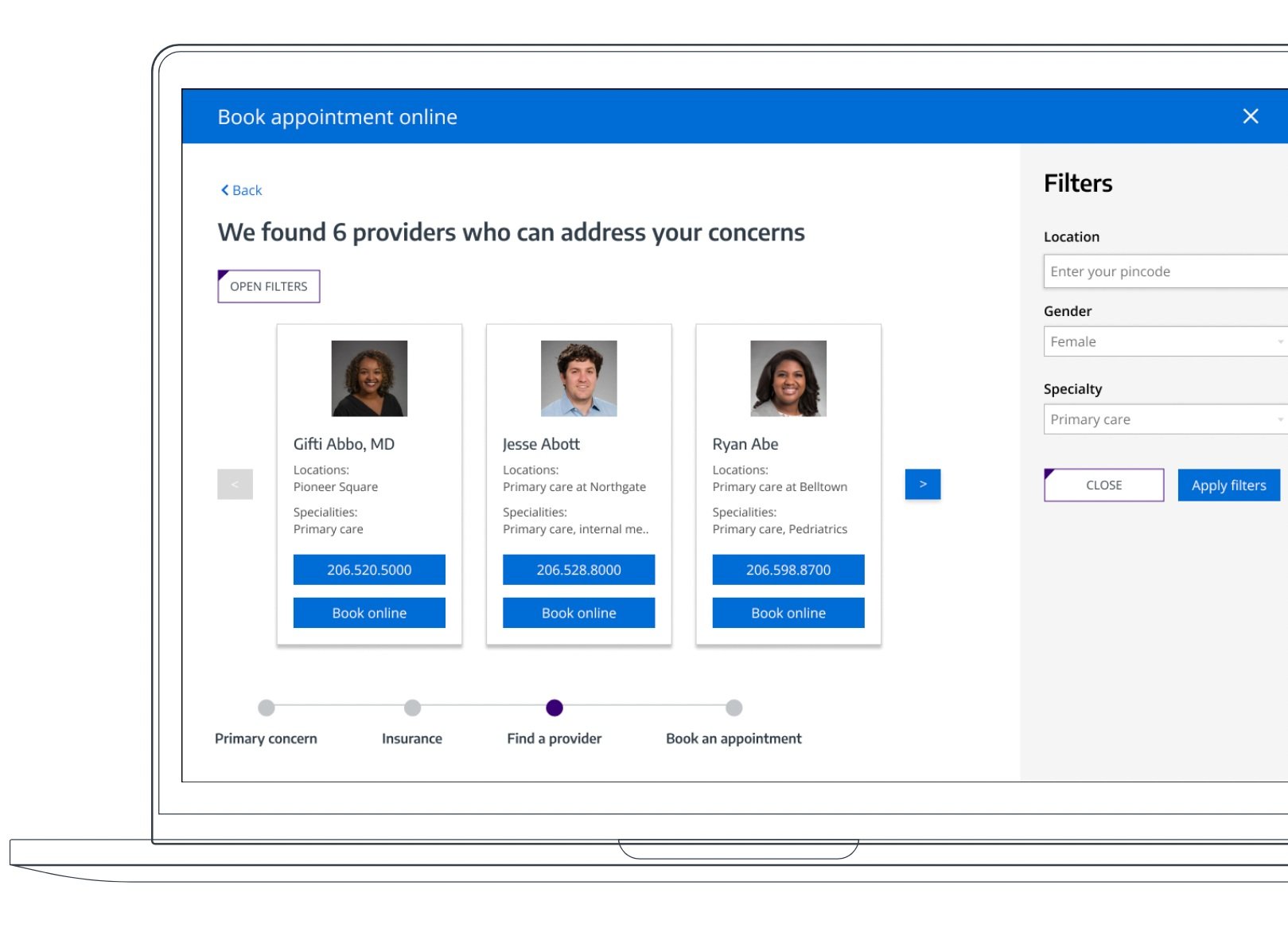Spring 2023
Healthcare has an Information Problem
A New Care-Finding Information Experience
We’re introducing a booking wizard that brings the information to you, and a Care-Corner, a smart guide that provides suggestions and answers questions.
Booking Wizard - Using natural language processing and a recommendation system, the new book-an-appointment process brings care to the user.
Contextualized Smart Guide - CareCorner is a contextual smart guide available to anticipate needs and provide clarity.
CONTEXT
For our capstone project, we are partnering with UW Medicine (UWM) and their Digital Experience team to redesign how patients find healthcare. The digital experience team handles the website of UWM and how users navigate the pages and resources to find the care they need. We have been tasked with defining problems users are having when seeking care and finding solutions to those problems holistically. Although our sponsor has identified problems with the current web experience, such as search results being returned in an arbitrary order or different silos of entry not being entirely cohesive, our approach– approved by the sponsor– is one that evaluates the whole healthcare-seeking process from start to booking (or in this case, MyChart). As such, we are not limited to having to redesign the website and can think more broadly in terms of digital solutions.
As part of our research process, we conducted a literature review, competitive analysis, survey, and are in the process of conducting interviews with both subject matter experts and users. These methods helped reveal key findings with strong alignment. Some broader challenges in the space that emerged include long waiting times for patients, unclear information on insurance or billing, and providers not being open to new patients or taking appointments online. With the UWM website in particular, we noted issues such as the lack of a dedicated appointment booking experience. We hope to continue our research and dive deeper into findings with additional interviews, heuristic evaluation, and user journey development at the start of next quarter.
With these research findings having laid the groundwork, we are confident in our next steps going into the spring quarter. As mentioned, we will be wrapping up our research to build out our understanding of both users’ and providers’ perspectives, followed by ideation, prototyping, testing, and iterating. While at this current point our final deliverable is likely a digital product given the scope of our sponsor and project, we are keeping an open mind and are excited to enter the next stage of capstone.
Design Question
How might we create the best-in-class holistic care-finding experience?
PROTOTYPE
Demo Video
Research Insights
Don’t make me call
Patients only like to call in if they have questions or clarifications they need help with - this could be questions like: “Is this the right type of physician I should see?” “I cant find what I am looking for - can you help?” “Should I be seeing a PCP or urgent care for this?”
If a patient knows what they are doing (who they need to see) then they would rather book online with all their info in one place. This often looks like a patient having a browser window open with the scheduling app (MyChart) for appointment availability, a map with directions from home to the appointment location, a detailed bio about the physician, an insurance website, and cross-referencing with their own calendar for availability.
If a patient has special needs, like they are blind or elderly and don’t use computers, then they will only be calling in since most websites (including uwmedicine.org) do not work well with their assistive technology.
Lack of Insurance Information
The lack of clarity or miscommunication in the care-finding experience is the most frustrating part of the process for patients. The lack of clarity in the insurance process (and potential costs) provides patients with the most distress.
Patients will check their insurance website and the provider’s website before scheduling to ensure the provider is covered by their insurance. This process is tedious and involves multiple places to check and recheck.
Additionally, the terminology used by insurance providers can be confusing for first new users.
All pieces in one place
When speaking with patients about their experience of finding medical care, the positive + negative experiences they have had, we asked about what the ideal process would look like for them. Consistently, participants mentioned wanting to have all the pieces in one place! This includes the insurance information, provider information, appointment information - everything together to help give a holistic picture of their process.
Prioritize Location + Connection
When talking to patients about what they prioritize when finding a medical care provider, the top of the list was the location and closely followed by connection with the provider.
For the location, they were searching for somewhere that was easily accessible given their schedule and transportation requirements. This could be somewhere they can transport themselves to in the limited time allotted in their schedule or somewhere that took into account public transit routes and/or parking availability.
For connection, they were looking for a provider that understood and truly listened to them. If they could not find any provider within their area then they might prioritize this aspect and look outside their immediate physical location for someone that did want to connect with them and foster that relationship for years to come. This could be someone who was African American with PCOS looking for someone that didn’t dismiss their experience but really took the time to understand and build a treatment plan that worked for them.
Lastly, there was a hodgepodge of secondary priorities like if a provider is covered by insurance, if appointments are available within a given amount of time (usually the next couple of months), and if a provider is accepting new patients.
Research methods
literature review
site map
survey
patient interviews
subject-matter expert interviews
heuristic evaluation
concept study
usability study
Design Process
Design Principles
clear and actionable - as clear and simple as possible for patients
focus on the holistic experience - bring the pieces together into a single source of truth to help them weigh their options
Empower choice in communication - while calling may be unavoidable due to systems in place, finding alternatives or workarounds may be possible to allow patient comfort
set expectations - be clear and upfront about what is to come and how long things might take and what next steps (ex. how long, all the steps in the entire flow)
Team
Catherine Most
I’m a User Experience Researcher that’s worked on consumer products and enterprise products ranging from companies with a research team of one to thousands. I’m also interested in understanding how people use technology and where it can assist in our everyday lives.
Simon Sun
simonsihaosun@gmail.com
I’m a full-time masters student aiming to work in UX or product design. I have previously interned at Seattle Children’s, working with their Design & Insights team to develop data visualizations. I’m interested in exploring the intersection of emerging technology and interaction design, particularly through an accessibility lens. Prior to working in UX, my background is in computer science, with a minor in film.
Natasha Paul Stephen
natashapaul1996@gmail.com
I’m a Product Designer that’s worked on CRM products and designed and shipped B2B features. I’ve worked on both mobile and web applications and aim to study more about behavioral design. I’m also interested in using Human Computer Interaction research in everyday design.
THANK YOU
A special thanks to the UW HCDE teaching staff, our research participants, and our UW Medicine sponsors. We could not have done this without your patience and wisdom!









